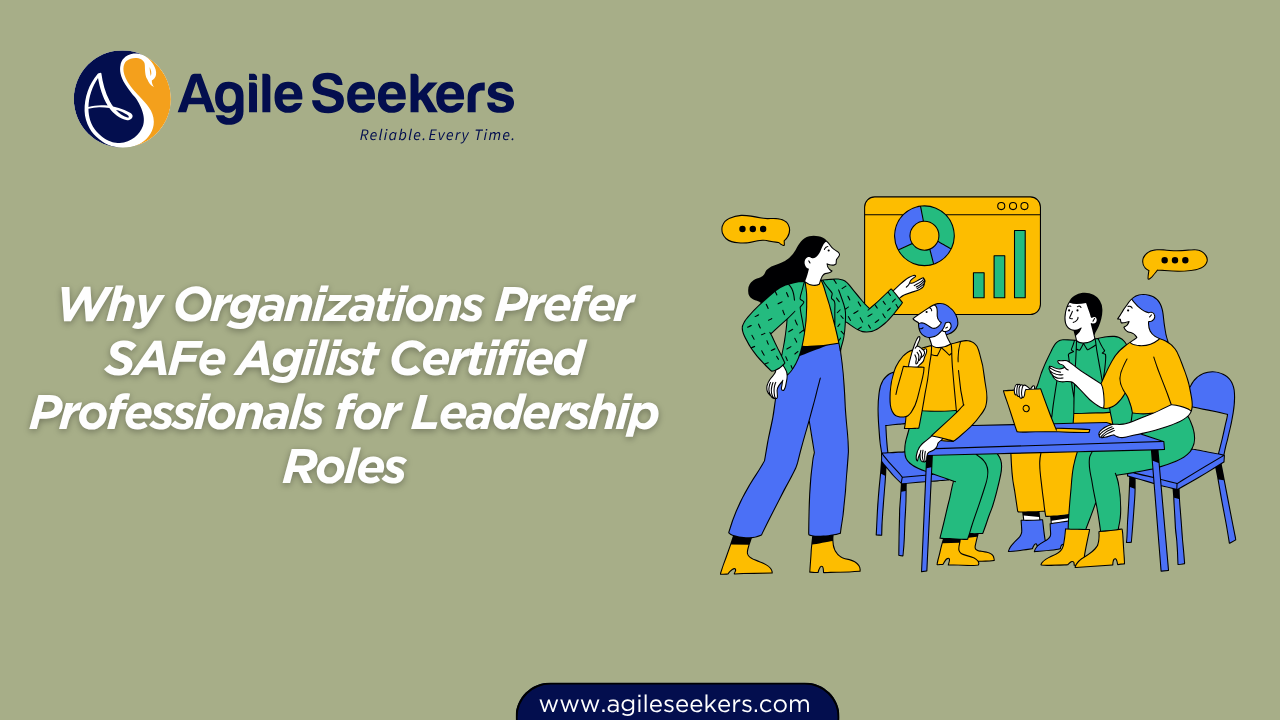Why Organizations Prefer SAFe Agilist Certified Professionals for Leadership Roles

When enterprises embrace Agile at scale, they’re not just adopting new processes—they’re rethinking leadership. And that’s why professionals with a SAFe agile certification consistently stand out.
These leaders combine strategic thinking, systems awareness, and people-centric leadership to guide transformation effectively. Let’s break down why organizations prefer SAFe Agilist certified professionals for key leadership positions.
1. They Think Systemically, Not in Silos
Most traditional managers optimize their own departments. SAFe Agilist leaders see the entire system—the value streams, dependencies, and cross-functional impacts.
Through Leading SAFe training, they develop a systems-thinking mindset that enables them to make decisions benefiting the entire enterprise rather than just a single function.
For example, instead of pushing one team to deliver faster, they focus on improving end-to-end flow across multiple teams. That shift from local optimization to system-wide alignment is what drives sustainable success.
2. They Bridge Strategy and Execution
The biggest leadership gap in many enterprises is translating strategy into executable plans. SAFe-certified leaders close that gap.
During SAFe agilist certification, professionals learn to align organizational goals with delivery through OKRs, Portfolio Kanban systems, and Program Increments (PIs).
This ensures that every sprint, feature, and release connects back to enterprise objectives—removing the disconnect between top management and Agile teams.
3. They Lead Large-Scale Change with Clarity
Leading transformation at scale takes more than enthusiasm. It takes structure, empathy, and a data-driven approach.
Through SAFe agile certification training, leaders learn Lean Change Management—experimenting, inspecting, and adapting across the organization.
They build trust and alignment without relying on command-and-control tactics, making them ideal change agents during enterprise Agile transformations.
4. They Bridge Business and Technology
SAFe-certified leaders act as translators between business priorities and technical realities.
They understand customer needs, market trends, and architectural constraints—all while ensuring teams build the right thing the right way.
This ability to balance innovation with stability is one reason enterprises prefer SAFe leaders for strategic roles. Independent studies from the Scaled Agile Framework community highlight how this balance drives faster delivery and stronger business alignment.
5. They Build a Culture of Continuous Improvement
Leadership isn’t about maintaining status quo—it’s about nurturing growth.
Certified SAFe leaders create a culture where improvement is constant. They encourage retrospectives, facilitate Inspect & Adapt sessions, and promote learning through experimentation.
Over time, this mindset transforms the organization from simply “doing Agile” to truly being Agile—one that continuously evolves based on feedback and results.
6. They Align Teams Around a Shared Vision
Alignment is one of the toughest challenges for any large enterprise. SAFe leaders solve it through clear communication and visual alignment tools.
Using PI Objectives, vision statements, and portfolio roadmaps—concepts taught during Leading SAFe training—they ensure that every team understands how their work contributes to the bigger picture.
When everyone works toward a common vision, silos disappear, motivation rises, and delivery becomes predictable.
7. They Make Data-Driven Decisions
Modern leaders rely on data, not assumptions. SAFe Agilists leverage flow metrics, customer satisfaction scores, and predictability measures to guide decisions.
They also practice Lean Portfolio Management—prioritizing work that delivers maximum value instead of just more output.
This data-driven mindset ensures leadership decisions are transparent, measurable, and outcome-focused.
8. They Empower Teams with Decentralized Decision-Making
Agile thrives when teams are empowered. SAFe-certified leaders know how to distribute authority without losing control.
They set clear guardrails, enabling teams to make local decisions while maintaining alignment with enterprise strategy.
This balance between autonomy and accountability accelerates innovation and drastically reduces decision latency—a key advantage in fast-moving markets.
9. They Build Trust and Psychological Safety
The best leaders don’t just manage—they create an environment where people can thrive.
SAFe Agilist leaders understand that innovation happens when teams feel safe to speak up, challenge assumptions, and take calculated risks.
They focus on building trust and removing fear from decision-making, which leads to higher engagement and creativity across teams.
10. They’re Recognized as Enterprise Change Agents
Enterprises see SAFe-certified professionals as transformation catalysts.
They know how to lead Agile Release Trains (ARTs), facilitate PI Planning sessions, and connect strategy to delivery.
Professionals with a SAFe agilist certification aren’t just practitioners—they’re coaches who guide enterprises through complex change with confidence.
11. They Drive Measurable Business Agility
Organizations don’t invest in SAFe leaders just for process—they invest for outcomes.
Through their SAFe agile certification, these leaders learn to align business strategy, governance, and execution around customer value.
The result is improved time-to-market, better predictability, and faster response to change—core elements of business agility that every enterprise needs to survive and grow.
12. They Develop Future Leaders
The strongest leaders build more leaders.
SAFe Agilist professionals mentor Scrum Masters, Product Owners, and team leads—helping them adopt Lean-Agile principles and develop their leadership skills.
This “leader-multiplier” effect creates a self-sustaining ecosystem where Agile thinking spreads naturally across teams and portfolios.
Final Thoughts
Enterprises prefer SAFe Agilist certified professionals for leadership roles because they bring a rare mix of vision, structure, and adaptability.
They think beyond project delivery—they shape how organizations function, learn, and evolve.
If your goal is to step into a leadership role that drives transformation and measurable business outcomes, consider enrolling in SAFe agile certification training.
It’s not just a credential—it’s the foundation for leading large-scale change with clarity, confidence, and real impact.
Also read - The ROI of Becoming a SAFe Agilist for Mid-Career Professionals
Also see - Unlocking Global Opportunities Through SAFe Agilist Certification




















